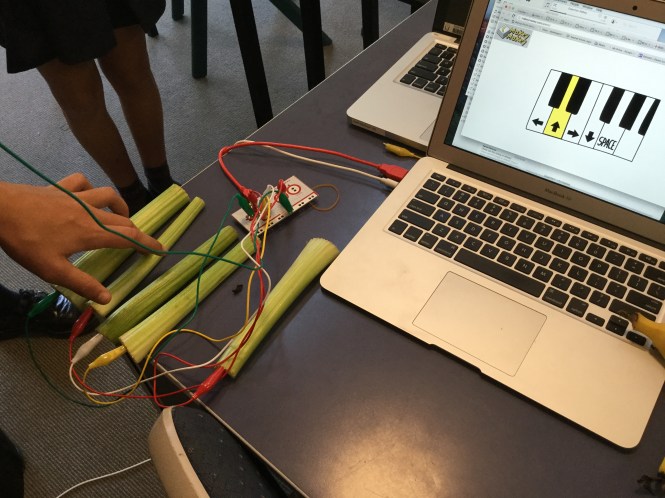Practical lessons and technology provide a great opportunity for Enquiry-Based Learning (EBL). We don’t realise how often as teachers we are doing the instruction and teaching the content rather than letting students find their own way. EBL is where the teacher becomes a facilitator and the students lead their own learning. While it can be a whole unit approach, you can also use the elements for lessons or parts of a lesson.
I saw this in action when I took MaKeyMaKey into my Year 7 and 8 Music classrooms. It is a simple circuitry set that over-rides keyboard keys so you can control a computer via other objects. So we played bongo drums with a banana and celery and then played a keyboard with fruit, lollies and people!

Will a lolly banana work? Will chips work? What if I hold it in my teeth? Does it work if we touch hair? What about clothes? What if I am touching someone else? How far will it work? My standard answer was “I don’t know, let’s try!”, and they did. Some things worked and others didn’t, then I would ask why, and it would set them on another experiment to find the answer.
Occasionally I would pose a question to get them thinking, but for the most part they came up with questions I had not even considered!
I deliberately mixed up the pitch sounds, rather than have them ordered. When students wanted to start playing songs we had been learning in class, they realised it was hard remembering which note was which, so a student took on the leadership role and moved them all into position by hearing the sounds and working out which was higher or lower. Not only were they taking control of their own learning but they were meeting learning outcomes in Music and Science while being fully engaged and in awe. They were learning through play, enquiry and experimentation.
When someone asked “What if I am touching someone else?”, we tried and it still worked. Then another student asked “How many will it work for?”. Again, I said “I don’t know, let’s try!” and in a very orderly fashion the students organised themselves to add one more in a circle, then another and checked the experiment each time before adding another person. We ended up with a ring of over 15 students and they knew the circuit had to remain closed to work. If someone let go, they would say “you have to be connected”.
Students were learning, having fun, engaged, asking pertinent questions, using their imagination, being creative, experimenting, collaborating and working in teams. I had given no directions in any of this, other than a simple demonstration and started off with posing, “Why?”. This was fantastic to watch and made me wonder why, as teachers, we don’t do it more often. Do we feel we need to always have the answers? Do we fear lack of control? I was still facilitating the learning and overseeing everything in the classroom, but giving them the flexibility to head in their own directions to find answers to their own questions. And I was a very proud observer.
